Library History
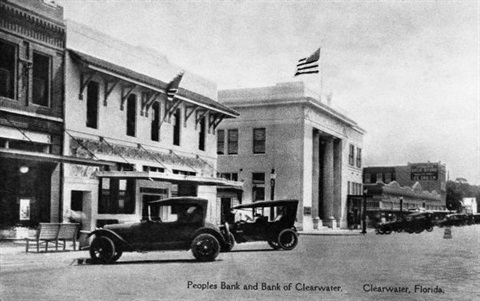
History of the Clearwater Public Library System
Beginnings (1900-1939)
Clearwater was a small farming community in 1900 when 343 people lived on the bluff overlooking Clear Water Bay. The next 10 years marked the introduction of a telephone exchange, electric lights, an ice factory, the paving of Fort Harrison Street, and the addition of 848 citizens. A fire department was established in 1910 after the entire business block burned on the north side of Cleveland Street and Osceola Avenue.
Pinellas County was established when the peninsula, formerly a part of Hillsborough County, was re-defined as a separate county in 1911. Enthusiastic Clearwater citizens built a courthouse overnight to win for their young city the designation of county seat over rival St. Petersburg. Residents began to invest time and effort in becoming more than an agricultural center.
Also, in 1911, the Clearwater Library Association opened a subscription library on the second floor of Peoples Bank on Cleveland Street. During the next few years, its use and citizen support were enough to convince the Carnegie Foundation to approve a $10,000 grant for the construction of a permanent library building. The city of Clearwater had to provide a site and promise support and maintenance. The library opened to the public on September 14, 1916.
Miss Margaret Duncan was appointed Librarian at a salary of $50 per month, and library services were publicized on the Strand Theater's (now the Capitol Theatre) moving picture screen.
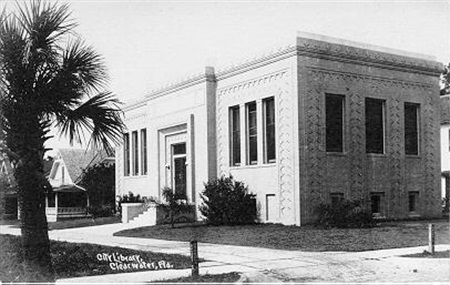
The first year 1,277 visitors borrowed 2,792 books. The library had a reading room with two Clearwater newspapers, the Tampa Tribune, the Chicago Tribune, magazines, and reference books including the 11th edition of the Encyclopedia Britannica. There was a rental shelf, offering materials for two cents per day, in addition to the permanent and donated circulating collection of the "very latest literature." Patrons could check out two books at once, only one of which could be fiction.
The impact of the Depression on the Clearwater Public Library was similar to the effect on libraries across the nation: less money and more patrons. The budget was cut repeatedly. The building, now more than 14 years old, needed repairs. When the City Manager turned down the lowest available bid of $40 to fix a damaged ceiling, Library Director Grace Mease bought the materials and hired laborers to fix it for $13.65. The City Manager reimbursed her. However, faced with a sudden budget cut of $1000 in 1932, the Board unanimously approved the dismissal of Mease and the hiring of former assistant Annie Owen.
Expansion and Change (1940-1979)
Over the next ten years, the staff, collection, services and circulation grew steadily. Space was at a premium, seating was inadequate, and catalog cards were stored in cardboard boxes. The City Council approved an addition to the library building in 1939, just in time for the library to offer service to the service members and their families stationed in the area during World War II.
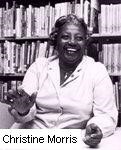
As early as 1917, Library Board minutes note a discussion for a "colored library proposition," but the main location was the focus of all efforts. After the war, black citizens brought the real need for a branch library to the attention of Library Director Sarah Byers. The City Council agreed that if they could find a building and a librarian, the city would fund it. Librarian Christine Morris opened the doors to the first library in the North Greenwood neighborhood at Pennsylvania and Cedar Street on March 15, 1950.
The rented library soon outgrew its quarters. A new building, opened on Palmetto Street next to Pinellas High School in September, 1962 with 15,000 books. The Edward Allen Henry, Jr. Special Collection on Negro Culture and History was authorized in 1970 to be housed at that branch, where it remains today. It is now known as the Christine Wigfall Morris African American Collection.
By the end of the 1950s, the original library building suffered from basement flooding as well as wall and ceiling damage and a lack of parking. It could also no longer comfortably accommodate a collection that had swelled to 75,000 items. The City Council agreed to renovate the building, which was rededicated on December 1, 1961.
The decade of the 1960s saw construction of the small branch libraries, the organization of the Friends of the Library, and the provision of Main Library service on Saturday afternoon at the request of area schools.
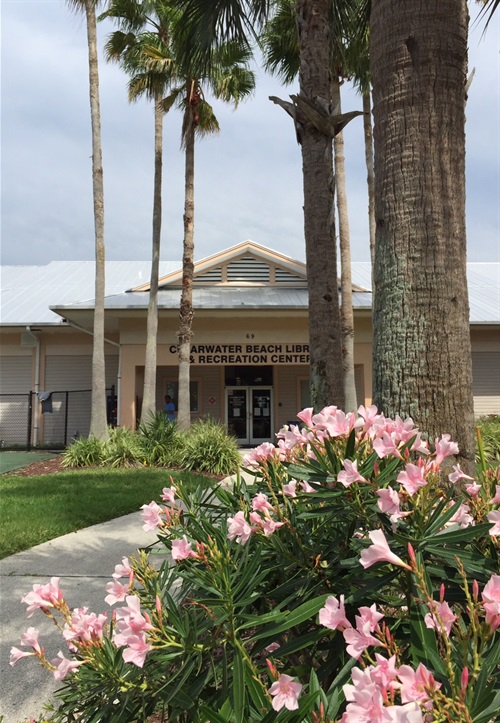
The Beach Library opened July 21, 1961 under the roof of the Memorial Civic Center. It became part of the Clearwater Beach Recreation Complex in 2008, the first shared-use venture between the city of Clearwater Parks and Recreation Department and the Clearwater Public Library System.
The momentum of growth and change in the area accelerated, reflecting added services at the city’s libraries. The Friends of the Library reorganized in 1971 and grew, in the next ten years, to well over 500 members who, through books sales and other fundraising projects, supported the Library in many ways. The projected population growth statistics mandated the eventual necessity for additional branches in the east and north sections of the city. As a temporary measure, a "Twig" was opened in 1978 in the training room of Fire Station #5 by the Clearwater Mall.
Spurred by the population growth, the City Council approved another addition to the Main Library, which was funded in part by a large donation from Mr. and Mrs. William Adler and a grant from the Library Services and Construction Act (LSCA). It was dedicated on October 19, 1980.
Recent Happenings (1980-present)
After the addition was completed, the Main Library’s problems of space were temporarily settled and attention returned to the building of branches. Though a 1982 referendum failed, it was clear that most citizens were behind the creation of community libraries. The City Council approved a .25 millage increase for construction of an East Library, which was opened to the public in 1985. The year before, the North Greenwood Library was renovated and the year following, the City Council approved the construction of a Countryside Library. The building was dedicated on October 23, 1988. The decade also saw the adoption of a computerized circulation system, which allowed easier sharing of resources among libraries and expanded access to materials by patrons.
In July 2000, voters authorized the city to issue bonds for a new Main Library to be built on the approximate site of the original library. The building was designed by world-renowned architect Robert A.M. Stern, Dean of the Yale University School of Architecture. It was built to serve as a cultural attraction and northern anchor of the downtown area, with gallery exhibits, special programs, and a variety of community activities. The grand opening was May 1, 2004.
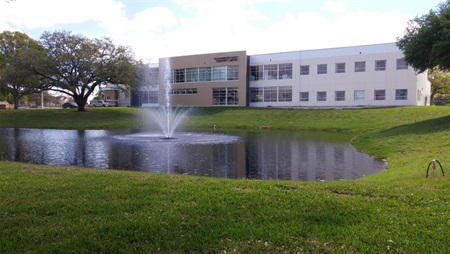
The aging branch libraries at Countryside and East, which were built in the mid-80s, got new facilities in 2015 and 2018, respectively. The new Countryside Library is situated next to the Countryside Recreation Complex, allowing for combined programming and resource sharing. The new East Community Library was built on the campus of St. Petersburg College and operates as a joint use facility with the college to serve both residents and students.
The Clearwater Public Library System continues to offer exceptional services and resources to the residents of the region as it adopts innovative materials and programs to meet their ever-changing needs.
Directors of the Clearwater Public Library System
- 1911 Miss Thomson
- 1911 Margaret Duncan
- 1913 Marie Allen
- 1914 Miss Garrett
- 1915 Margaret Duncan
- 1916 Margaret Duncan & Constance Chase (apprentice)
- 1918 Constance Chase
- 1920 Grace Mease
- 1932 Annie Owen
- 1942 Sarah Byers
- 1971 Elliott Hardaway
- 1976 Althea Andersen (Interim)
- 1978 Nancy Zussy
- 1980 Aleta Cozart (Interim)
- 1981 Linda Mielke
- 1991 Althea Andersen, Linda Lange, Marsha McGrath, Carolyn Moore (co-directors)
- 1992 Arlita Hallam
- 1999 John Szabo
- 2005 Barbara Pickell
- 2017 Jennifer Obermaier